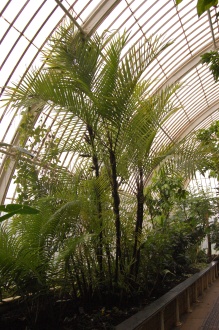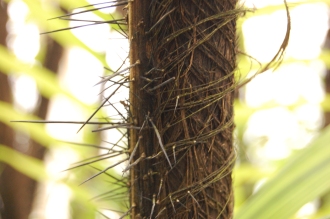Position: Full sun to light shade
Flowering period: All year round
Soil: Moist, well drained
Eventual Height: 10m
Eventual Spread: 4m
Hardiness: 10b, 11, 12, 13
Family: Arecaceae
Bactris major is an evergreen palm with a varying habit. Its mid green leaves are pinnate, up to 1.8m long and are composed of up to 92 leaflets.. Its dark brow/ black trunk may achieve a diameter of up to 6cm and is covered in long thin spines which are up to 11cm long. Its bark. Its flowers appear on a stem which is up to 40 cm long. Its black/ purple fruit is ellipsoid, up to 4.5cm long and 3.5cm broad.
Bactris major, commonly known as Lata Palm, Kawmaka, Cubaro or Prickly Palm, is native to Mexico, Trinidad, Central America and north South America. In its native habitat it grows in forests and open areas. Its fruit are eaten by local populations.
The etymological root of the binomial name Bactris is derived from the Greek baktron meaning ‘stick’, in reference to its use as a walking stick. Major is from the Latin meaning ‘larger’.
The landscape architect may find Bactris major useful as an evergreen palm which may form attractive clumps. It may be planted as an effective barrier plant. Care should be taken when locating this palm due to its extremely spiny stem. This palm needs high humidity.
Ecologically, Bactris major flowers are attractive to pollinating insects. Its fruit are attractive to some birds and mammals.
Bactris major prefers moist, fertile, well-drained soils. It tolerates most pH of soil. It tolerates wet and flooding soils.







Leave a comment